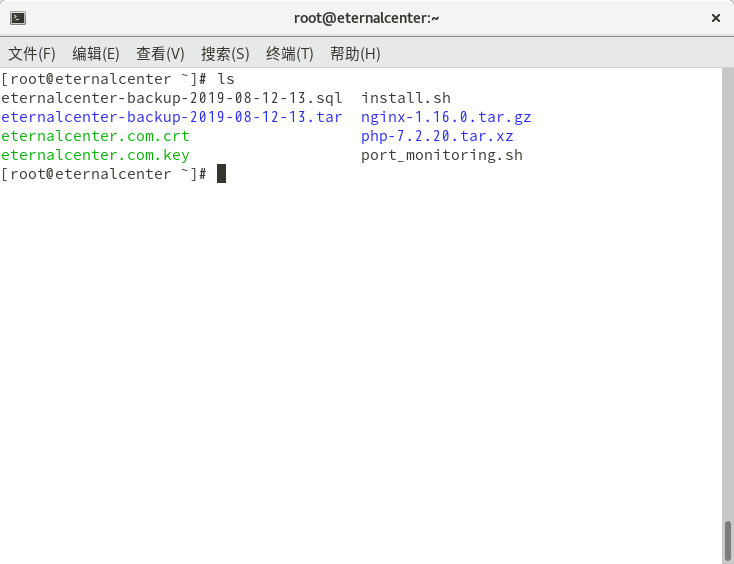纪念:站主于 2019 年 11 月完成了此开源实验,并将过程中的所有命令经过整理和注释以后,形成以下教程
步骤目录:
步骤一:规划拓扑
1.1 服务器列表
1.2 服务器列表简介
步骤二:系统环境要求
步骤三:所有数据库服务器安装 MariaDB 或 MySQL 数据库
3.1 所有数据库服务器安装 MariaDB 或 MySQL
3.2 设置所有数据库服务器开机自启 MariaDB 或 MySQL
步骤四:配置 MairaDB&MySQL 互为主从结构
4.1 将数据库服务器 22 设置为数据库服务器 21 的从库
4.1.1 开启数据库服务器 21 的 server-id 和 binlog 日志
4.1.2 重启数据库服务器 21 的数据库
4.1.3 在数据库服务器 21 的数据库中创建用于同步的用户
4.1.3.1 进入数据库
4.1.3.2 创建数据库服务器 21 用于被数据库服务器 22 同步的 MariaDB 用户
4.1.3.3 刷新数据库服务器 21 里所有用户的权限
4.1.3.4 查看数据库服务器 21 的 MariaDB 的主库参数
4.1.4 让数据库服务器 22 同步数据库服务器 21
4.1.4.1 启动数据库服务器 22
4.1.4.2 进入数据库服务器 22 的数据库
4.1.4.3 同步主库
4.1.4.4 启动从库状态
4.1.4.5 查看从库状态
4.2 将数据库服务器 21 设置为数据库服务器 22 的从库
4.2.1 关闭数据库服务器 22 的数据库
4.2.2 开启数据库服务器 21 的 server-id 和 binlog 日志
4.2.3 启动数据库服务器 22 的数据库
4.2.4 在数据库服务器 22 的数据库中创建用于同步的用户
4.2.4.1 进入数据库
4.2.4.2 创建数据库服务器 21 用于被数据库服务器 22 同步的 MariaDB 用户
4.2.4.3 刷新数据库服务器 22 数据库里所有用户的权限
4.2.4.4 查看数据库服务器 22 的 MariaDB 的主库参数
4.2.5 让数据库服务器 21 同步数据库服务器 22
4.2.5.1 进入数据库服务器 21 的数据库
4.2.5.2 同步主库
4.2.5.4 查看从库状态
步骤五:测试 MariaDB&MySQL 互为主从集群
5.1 进入数据库
5.2 创建测试库
5.3 进入测试库
5.4 创建测试表
5.5 在数据库服务器 21 上插入测试数据
5.6 在数据库服务器 22 上插入测试数据
5.7 在两个数据库里都可以看到对方插入的测试数据
具体的操作步骤:
步骤一:规划拓扑
1.1 服务器列表
数据库服务器 21 IP 地址:192.168.1.21
数据库服务器 22 IP 地址:192.168.1.22
1.2 服务器列表简介
数据库服务器 21 和 数据库服务器 22 相互同步对方的数据
步骤二:系统环境要求
1) 所有服务器的系统都需要是 CentOS 7 版本
2) 所有服务器都要关闭防火墙
3) 所有服务器都要关闭 SELinux
4) 所有服务器系统都要配置好可用的软件源
5) 需要按照拓扑图给对应的服务器配置好 IP 地址和主机名
6) 所有服务器都要可以相互 ping 通自己和对方的 IP 地址和主机名
步骤三:所有数据库服务器安装 MariaDB 或 MySQL 数据库
3.1 所有数据库服务器安装 MariaDB 或 MySQL
(分别在数据库服务器 21 和数据库服务器 22 上执行以下步骤)
# yum -y install mariadb-server(补充:这里以安装 MariaDB 数据库为例)
3.2 设置所有数据库服务器开机自启 MariaDB 或 MySQL
(分别在数据库服务器 21 和数据库服务器 22 上执行以下步骤)
# systemctl enable mariadb(补充:这里以开机自启 MariaDB 数据库为例)
步骤四:配置 MairaDB&MySQL 互为主从结构
4.1 将数据库服务器 22 设置为数据库服务器 21 的从库
4.1.1 开启数据库服务器 21 的 server-id 和 binlog 日志
(只在数据库服务器 21 上执行以下步骤)
# vi /etc/my.cnf将部分内容修改如下:
[mysqld]
server-id=1
log-bin=mariadb-bin
......(
补充:这里以
1) 将 server-id 设置为 1
2) 启动 binlog 日志,并将 binlog 日志的前缀设置为 mariadb-bin
为例
)
(注意: 集群里的各个数据库的 server id 不能一样)
4.1.2 重启数据库服务器 21 的数据库
(只在数据库服务器 21 上执行以下步骤)
# systemctl restart mariadb(补充:这里以重启 MariaDB 数据库为例)
4.1.3 在数据库服务器 21 的数据库中创建用于同步的用户
4.1.3.1 进入数据库
(只在数据库服务器 21 上执行以下步骤)
# mysql -p4.1.3.2 创建数据库服务器 21 用于被数据库服务器 22 同步的 MariaDB 用户
(只在数据库服务器 21 上执行以下步骤)
> grant replication slave on *.* to 'backup'@'192.168.1.22' identified by 'backup';4.1.3.3 刷新数据库服务器 21 里所有用户的权限
(只在数据库服务器 21 上执行以下步骤)
> flush privileges;4.1.3.4 查看数据库服务器 21 的 MariaDB 的主库参数
(只在数据库服务器 21 上执行以下步骤)
> show master status;
+--------------------+----------+--------------+------------------+
| File | Position | Binlog_Do_DB | Binlog_Ignore_DB |
+--------------------+----------+--------------+------------------+
| mariadb-bin.000003 | 475 | | |
+--------------------+----------+--------------+------------------+
1 row in set (0.00 sec)(补充:这里显示的 master_log_file 和 master_log_pos 的参数会在后面配置从库中使用)
4.1.4 让数据库服务器 22 同步数据库服务器 21
4.1.4.1 启动数据库服务器 22
(只在数据库服务器 22 上执行以下步骤)
# systemctl start mariadb(补充:这里以启动 MariaDB 数据库为例)
4.1.4.2 进入数据库服务器 22 的数据库
(只在数据库服务器 22 上执行以下步骤)
# mysql -p4.1.4.3 同步主库
(只在数据库服务器 22 上执行以下步骤)
> change master to master_host="192.168.1.21",master_user='backup',master_password='backup',master_log_file='mariadb-bin.000003',master_log_pos=475;4.1.4.4 启动从库状态
(只在数据库服务器 22 上执行以下步骤)
> start slave;4.1.4.5 查看从库状态
(只在数据库服务器 22 上执行以下步骤)
> show slave status\G;
Master_Host: 192.168.1.21
......
Slave_IO_Running: Yes
Last_IO_Error: ......
......
Slave_SQL_Running: Yes
Last_SQL_Error: ......
......(补充:这里显示它的主服务器是 192.168.1.21)
(注意:这里要确保 Slave_IO_Running: 和 Slave_SQL_Running: 后面没有报错信息)
4.2 将数据库服务器 21 设置为数据库服务器 22 的从库
4.2.1 关闭数据库服务器 22 的数据库
(只在数据库服务器 22 上执行以下步骤)
# systemctl stop mariadb(补充:这里以停止 MariaDB 数据库为例)
4.2.2 开启数据库服务器 21 的 server-id 和 binlog 日志
(只在数据库服务器 22 上执行以下步骤)
# vi /etc/my.cnf(将部分内容修改如下)
[mysqld]
server-id=2
log-bin=mariadb-bin
......(
补充:这里以
1) 将 server-id 设置为 2
2) 启动 binlog 日志,并将 binlog 日志的前缀设置为 mariadb-bin
为例
)
(注意: 集群里的各个数据库的 server id 不能一样)
4.2.3 启动数据库服务器 22 的数据库
(只在数据库服务器 22 上执行以下步骤)
# systemctl start mariadb(补充:这里以重启 MariaDB 数据库为例)
4.2.4 在数据库服务器 22 的数据库中创建用于同步的用户
4.2.4.1 进入数据库
(只在数据库服务器 22 上执行以下步骤)
# mysql -p4.2.4.2 创建数据库服务器 21 用于被数据库服务器 22 同步的 MariaDB 用户
(只在数据库服务器 22 上执行以下步骤)
> grant replication slave on *.* to 'backup'@'192.168.1.21' identified by 'backup';4.2.4.3 刷新数据库服务器 22 数据库里所有用户的权限
(只在数据库服务器 22 上执行以下步骤)
> flush privileges;4.2.4.4 查看数据库服务器 22 的 MariaDB 的主库参数
(只在数据库服务器 22 上执行以下步骤)
> show master status;
+--------------------+----------+--------------+------------------+
| File | Position | Binlog_Do_DB | Binlog_Ignore_DB |
+--------------------+----------+--------------+------------------+
| mariadb-bin.000003 | 475 | | |
+--------------------+----------+--------------+------------------+
1 row in set (0.00 sec)(补充:这里显示的 master_log_file 和 master_log_pos 的参数会在后面配置从库中使用)
4.2.5 让数据库服务器 21 同步数据库服务器 22
4.2.5.1 进入数据库服务器 21 的数据库
(只在数据库服务器 21 上执行以下步骤)
# mysql -p4.2.5.2 同步主库
(只在数据库服务器 21 上执行以下步骤)
> change master to master_host="192.168.1.22",master_user='backup',master_password='backup',master_log_file='mariadb-bin.000003',master_log_pos=475;4.2.5.3 启动从库状态
(只在数据库服务器 21 上执行以下步骤)
> start slave;4.2.5.4 查看从库状态
(只在数据库服务器 21 上执行以下步骤)
> show slave status\G;
Master_Host: 192.168.1.22
......
Slave_IO_Running: Yes
Last_IO_Error: ......
......
Slave_SQL_Running: Yes
Last_SQL_Error: ......
......(补充:这里显示它的主服务器是 192.168.1.21)
(注意:这里要确保 Slave_IO_Running: 和 Slave_SQL_Running: 后面没有报错信息)
步骤五:测试 MariaDB&MySQL 互为主从集群
5.1 进入数据库
(分别在数据库服务器 21 和数据库服务器 22 上执行以下步骤)
# mysql -uroot -p5.2 创建测试库
(只在数据库服务器 21 上执行以下步骤)
> create database test1;5.3 进入测试库
(分别在数据库服务器 21 和数据库服务器 22 上执行以下步骤)
> use test1;5.4 创建测试表
(只在数据库服务器 21 上执行以下步骤)
> create table test1a(id int(10),name char(100),age int(10));(补充:这里随意创建了一张表格)
5.5 在数据库服务器 21 上插入测试数据
(只在数据库服务器 21 上执行以下步骤)
> insert into test1a(id,name,age) values('1','zmy','10');(补充:这里随意插入了一条数据)
5.6 在数据库服务器 22 上插入测试数据
(只在数据库服务器 22 上执行以下步骤)
> insert into test1a(id,name,age) values('2','ming','20');(补充:这里随意插入了一条数据)
5.7 在两个数据库里都可以看到对方插入的测试数据
(分别在数据库服务器 21 和数据库服务器 22 上执行以下步骤)
> select * from test1a;
+------+------+------+
| id | name | age |
+------+------+------+
| 1 | zmy | 10 |
| 2 | ming | 20 |
+------+------+------+
2 rows in set (0.00 sec)
